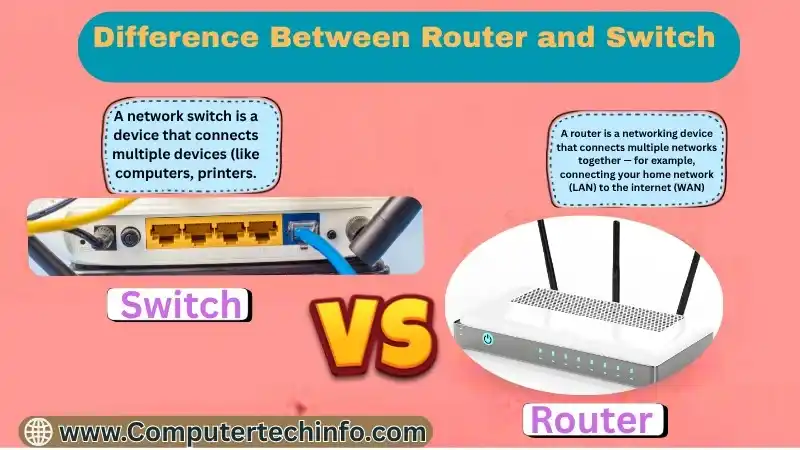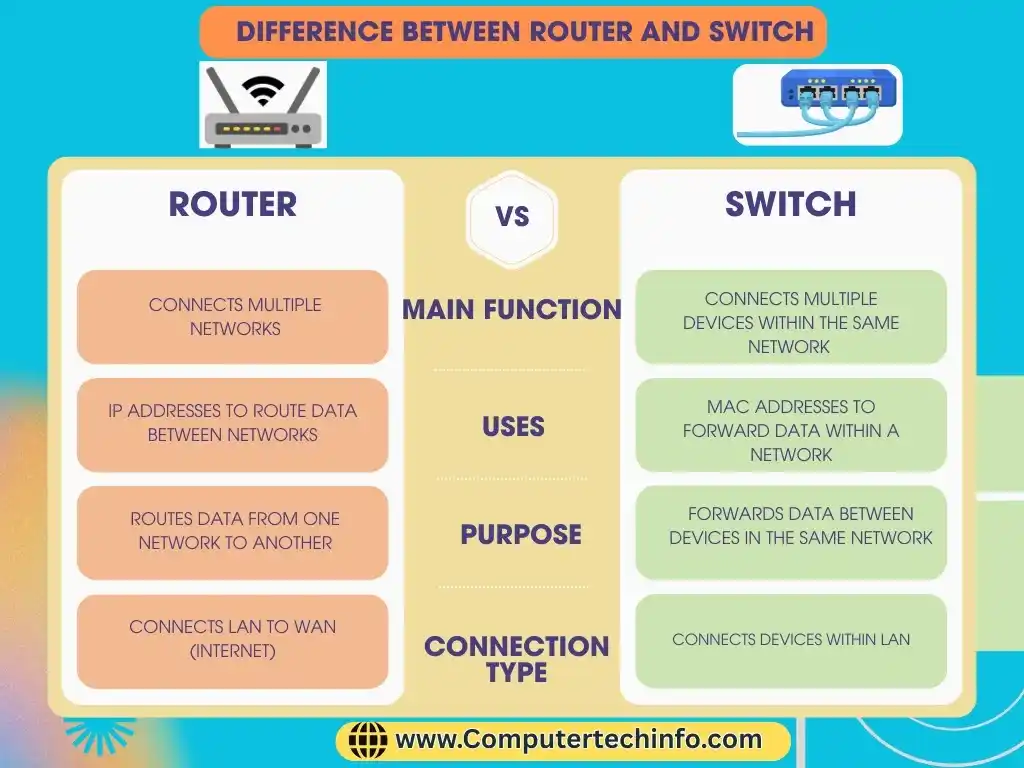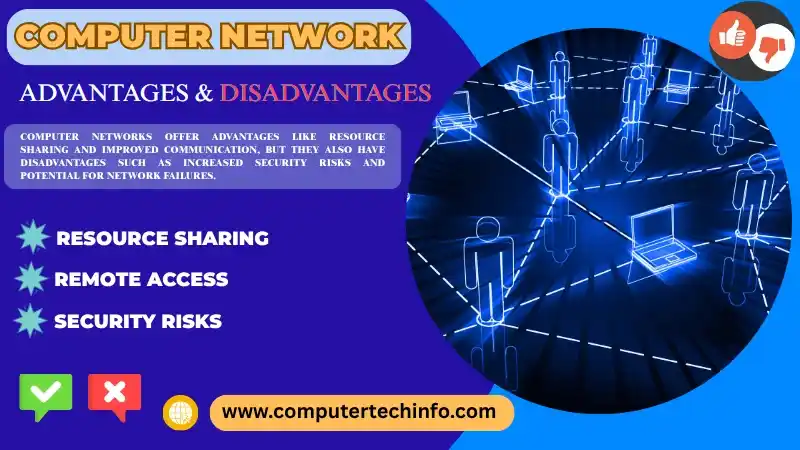Switches and routers are important networking devices that build the backbone of IT infrastructure. Ago we look at how they differ, it’s helpful to understand what each one does, along with their advantages and disadvantages | difference between router and switch.
Routers and switches are important networking devices that help connect different devices and networks. Because they both perform same connection roles, people many times find it difficult to understand the clear difference between the two.

Both routers and switches are devices using to connect networks. A router works at the network layer and control the best way like data to travel around networks. But, a switch connects multiple devices within the same network. In simple terms, routers link different networks close, whereas switches link devices within a single network.
Read this article to learn more around these two networking devices, how they work, and what build them different like each other.
What is a Router in Computer Networks?
A router are networking device that sends data packets between different computer networks. It works at the network layer and plays a basic role in run internet traffic.
Routers connect multiple networks at the same time and control data transfer between them.
When a data packet come, the router reads the network address in its header to figure out where it needs to go and then sends it to the correct point.
Types of Routers
There are various types of routers available, each designed like specific networking needs. These include the following types:
Wired Router
This type of router connects straight to a device using a wired connection. One port links to the modem to collect internet data, while another connects to a computer to share that data. Since only a few devices capable of connect to a wired router, wireless routers are many times more suitable. But, wired routers support NAT (Network Address Translation) technology, permit multiple computers to share a single IP address.
Wireless Router
A wireless router enables data to be sending and received without the need like cables. It functions as an access point within a local area network, using radio signals instead of wires to communicate with other devices and networks. When it receives data packets between wired broadband connections, it converts the binary data into radio signals like transmission and then changes them back into their original form when received.
Edge Router
An edge router is place at the boundary or edge of an Internet Service Provider (ISP) network. It delivers as the connection point between the internet and a wide area network (WAN). This type of router directs data packets between different networks, rather than within a single network, secure smooth communication around multiple networks.
Core Router
A core router is a high-performance device mainly used in large computer networks. It gets placing at the center of a network to control the flow of data within it. Core routers support multiple high-speed telecommunication connections and are secure like handling large volumes of internet traffic. Unlike edge routers, core routers capable of direct data packets within the network itself.
VPN Router
A VPN router is designed to enable secure network communication within a VPN setup. It allows multiple VPN-connected devices in different locations to communicate with each other. This router is built to connect directly to a VPN, secure that every connected device is protected by it. It also allows many devices to share the same encrypted connection, providing both security and good.
Virtual Router
A virtual router works utilize the Virtual Router Redundancy Protocol (VRRP). When the main router fails, the virtual router automatically receives over to save the network running smoothly. It combines multiple routers to share a single virtual IP address, secure continuous and reliable network connectivity.
Advantages of Router
Routers come with many advantages that make them important like networking.
They effectively control and direct data traffic between networks, secure smooth communication.
By blocking unauthorized way in, routers also increase network security.
They allow different types of networks to connect and communicate smooth
While allow multiple devices to share a single internet connection.
Many routers include parental control features to manage and limit internet use.
Additionally, they capable of rank important network traffic, improving performance like critical applications like video calls, gaming, or streaming.
What is Switch in Networking?
A switch is a device that using in a network to connect many devices, like computers and printers, so they capable of communicate with each other. It sends data to the correct device by understand its unique MAC address, effect communication faster and more effective within the network.
Switches work at the data link layer (Layer 2) of the OSI model and help direct network traffic to the right place. This improves both the speed and security of the network. They are mainly used in local area networks (LANs), permit devices to share information easily no matter where they are located within the network.
Uses of Network Switch
Switches connect devices in a network and use MAC addresses to send data directly to the right place.

They support VLANs, which group devices logically to build the network more secure and efficient.
Switches help control traffic by dividing broadcast networks, reducing not necessary data flow.
They use QoS (Quality of Service) to give priority to important data, secure smooth performance like key applications.
Many switches are achievable, allowing network admin to monitor and configure settings easily like better control.
Types of Switches
Unmanaged Switch: A simple plug-and-play device that requires no setup. It’s perfect like small or home networks.
Managed Switch: This offers full control with advanced features like VLANs and QoS. And network monitoring is commonly used in big or enterprise networks.
Smart Switch: A semi-managed option that provides limited configuration features, build it ideal like small to medium-sized businesses.
Advantages of Networking Switch
Switches help boost network bandwidth, allowing more data to flow smoothly around the network.
They connect directly to devices or workstations, secure effective communication between them.
Switches enhance overall network performance by managing data traffic successfully.
They reduce data collisions by creating separate collision domains like each connection, keeping the network stable.
Switches also reduce the load on single devices, like computers; build the network run more effectively.
Difference between Router and Switch in Networking
| Feature | Router | Switch |
| Function | A router connects many networks and directs data between, other side | Switch connects many devices in the same local area network |
| OSI Layer | Routers work usually at the Network Layer (Layer 3) | Switches work in the Data Link Layer (Layer 2). |
| Primary Role | A router finds the best way like data to move between networks | Switch sends data in a local network. |
| Device Type | Routers are used like message between different networks | Switches are used like message in the same network. |
| IP Address | Routers use IP addresses to send data | Switches use MAC addresses to drop data to the correct device. |
| Broadcast Domain | In a router, each port has its enjoy broadcast domain | Switch allows all ports share the same broadcast domain unless VLANs are set up. |
| Collision Domain | Routers provide different crash domain like each port that helps stop data crash. | Switches also like as work |
| Routing Table | Routers use a routing table to decide where to send data packets | Switches use a MAC address table to send data frames. |
| Network Type | Routers connect different networks like LANs, WANs, or MANs | Switches connect devices in a single LAN. |
| Data Transfer | Routers send data in the like of packets | Switches send data as like frames. |
| Failure Gateway | A router acts as the failure that connects devices to other networks | Switch does not pass this role. |
| Configuration | Routers are more involved to set up and control | Switches are simpler and easy to control. |
| Speed | Routers are generally slower because they analyze and route packets, spell | Switches are faster thanks to hardware-based data sending. |
| Cost | Routers are typically more expensive | Switches are more cheap and cost-effective like local networks. |
Basic Difference Between Router and Switch
Here are 5 basic differences between a router and a switch:
Function: A router connects different networks; other side a switch connects many devices in the same local network.
Address Use: Routers uses IP addresses to send data between networks, other side switches uses MAC addresses to send data through devices.
OSI Layer: Routers works on Network Layer (Layer 3), another side switches work are Data Link Layer (Layer 2).
Data Type: Routers control data packets, other side switches handle data frames.
Purpose: Routers enable communication between different networks (like a LAN and the Internet), other side switches allow communication in a single LAN network.
Bottom Lines
Routers are used to connect distant networks and send data in the like of packets.
On the other hand, switches are such devices that control data flow in a network by manage it like one input port to the correct output port.
In short, routers connect different networks; other side switches connect multiple devices in the same network.



